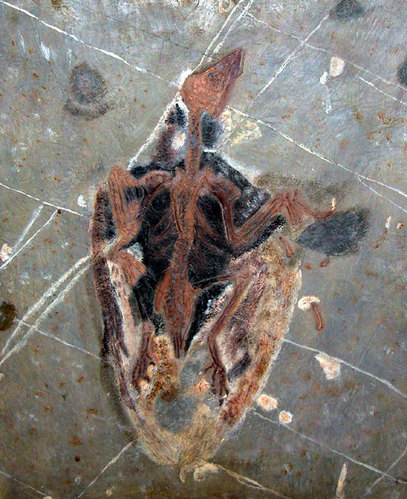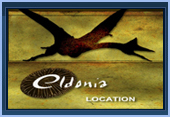- 일반명 : 공자새(콘푸시우스오르니스 상크투스)
- 학명 Scientific Name : Confuciusornis sanctus
- 형태 Mode : 판형 Board
- 시대 Age : 전기 백악기 Early Cretaceous
- 크기 L×W×H (m) (Size) : 0.5m×0.4m×0.1m
- 원산지 Location : 중국 요녕 Liaoning
Confuciusornis is a genus of crow-sized, primitive, birds from the Early Cretaceous of China, approximately 120 million years ago. Like modern birds, Confuciusornis had a toothless beak, but close relatives of modern birds such as Hesperornis and Ichthyornis were toothed, indicating that the loss of teeth occurred convergently in Confuciusornis and living birds. It was named after the Chinese moral philosopher Confucius (551-479 B.C.).
Recognized species are C. sanctus (the type species), C. dui, C. chuonzhous and C. suniae (the latter two being possibly synonymous with C. sanctus). A close relative, Changchengornis hengdaoziensis lived in the same time and region. Changchengornis also possessed the long tail feathers, as well as a noticeable downy coat of feathers. Recent cladistic analyses suggest that Confuciusornis is the most primitive pygostylian bird; it has a more primitive skull than Archaeopteryx, but it is the first known bird to have lost the long tail of Archaeopteryx and develop fused tail vertebrae (a pygostyle). One controversial study concluded that Confuciusornis may be more closely related to Microraptor and other dromaeosaurs than to Archaeopteryx, but this study was criticized on methodological grounds (Mayr et. al, 2005).
Fossils of Confuciusornis show that it had an exceptionally large humerus. A characteristic hole near its shoulder-end may have reduced the bone's weight. The furcula or wishbone was a simple bar, like that of Archaeopteryx. The sternum was relatively large and had a low keel which was raised at the caudal end. The bony keel may or may not have anchored a larger, cartilaginous, keel for enlarged pectoralis muscles. The scapulas were fused to the coracoid bones and may have formed a solid base for the attachment of flight muscles.The orientation of the glenoid (shoulder) joint was sideways, instead of angled dorsally as in modern birds; this means that Confuciornis was unable to lift its wings above its back. Like Archaeopteryx, it was thus incapable of the upstroke required for modern flapping flight (Senter, 2006), but the peculiar shoulder bones make it possible that it may have used another technique.
Confuciusornis is more advanced than Archaeopteryx in possessing a short tail with a pygostyle (a bone formed from a series of short, fused tail vertebrae), but more primitive than modern birds in retaining large claws on the forelimbs, a primitive postorbital skull, and relatively small sternum. The longest primary feathers remiges are more than three times the length of the hand and relatively longer than those of any living bird, while the secondary remiges were rather short by comparison. Thus, the wing shape was very unlike that of living birds. Many individuals show long, streamer-like tail feathers that may indicate sexual dimorphism and could have been used in courtship display, but the rest of the tail feathers were small and probably of little use in flight. The proportions of the toes suggest that they were used for both walking and perching, while the large claws of the thumb and third finger were probably used for climbing. The head probably had a small crest or tuft similar to that in today's mousebirds or turacos.
There are immature specimens known, and from the analysis of bone growth patterns of young adults it has been estimated that Confuciusornis reached maturity somewhat slower than extant small birds, but faster than advanced dinosaurs (de Ricqlès et al., 2003), which might indicate an omnivorous diet similar to modern crows.
It has been hypothesized that Confuciusornis fed on plant materials due to its toothless beak, but no gastroliths or stomach contents had been reported (Zhou & Zhang, 2003). Dalsätt and colleagues (2006) described a specimen (IVPP V133) that preserves 7 to 9 vertebrae and several ribs of a fish (probably Jinanichthys). These fish bones are formed into a tight cluster about 6 millimeters across, and the cluster is in contact with the seventh and eighth cervical vertebra of the bird. In this position it was likely in the crop of the bird, which may have been preparing to regurgitate a pellet when it died. No other fish remains are present in the slab. (Dalsätt et al., 2006).
The paradise kingfishers (genus Tanysiptera) of modern








































 수량을 선택해주세요.
수량을 선택해주세요.





































